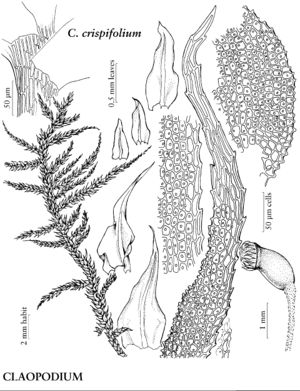Claopodium crispifolium
Rev. Bryol. 20: 16. 1893.
Illustrated
Basionym: Hypnum crispifolium Hooker Musci Exot. 1: plate 31. 1818
Revision as of 21:36, 5 November 2020 by imported>Volume Importer
Plants 4–8 cm, in loose mats, green to yellowish, often appearing brownish. Stems ± pinnate, smooth; paraphyllia absent. Leaves ovate, to 3 mm; margins serrate, limbidium present; apex long-acuminate, hair-point present; costa ending before apex, abaxial surface smooth; distal medial laminal cells hexagonal or subquadrate, 8–9 µm, 1-papillose. Seta 1–2 cm, rough. Capsule inclined to almost horizontal, oblong, 1.5–3 mm; operculum long-rostrate. Spores 9–12 µm, smooth.
Habitat: Rotten logs, tree bases, soil over rock
Elevation: low to moderate elevations
Distribution

Alta., B.C., Alaska, Calif., Idaho, Mont., Oreg., Wash., e Asia (Japan, Russian Far East).
Discussion
Selected References
None.
Lower Taxa
None.
